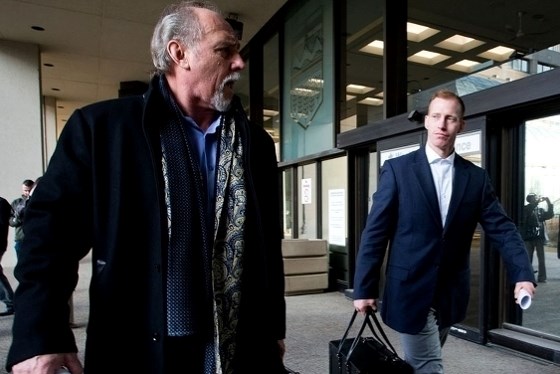Travis Vader's trial for the murder of St. Albert seniors Lyle and Marie McCann has hit another delay due to a lengthy voir dire hearing.
Ultimately Justice Denny Thomas ruled independent consultant and former Telus employee Bruce Funk could provide factual evidence about an investigation he did on behalf of the RCMP, but could not provide expert opinion to interpret the results he found. This ultimately limited some of the evidence he could provide. Factual evidence like what and where was allowed, but interpretive evidence like how and why was not.
Funk told court that RCMP gave him three tasks in September 2011, relating to locations and service areas of cellular towers on the Telus network. He said he was given cellphone records for two phones that would have been using the Telus network in July 2010: a Koodo phone registered to Lyle McCann, and a Virgin Mobile phone with a number Vader's ex-girlfriend Andrea Saddleback-Sexsmith testified she registered for Vader in the spring of 2010.
In his opening statement at the outset of the trial, Crown prosecutor Jim Stewart said he intended to show Vader had used the McCanns' phone July 3, the day they were last seen.
The second and third task were fairly straightforward: to identify which cell towers were used at several locations in and around Peers, Nojack, Edson and Minnow Lake; and to identify the spot travelling east on Highway 16 where a phone would first come into range of the Wabamun cell tower.
Funk explained he used a Samsung phone in debug mode, which gives numbers identifying which tower a call is being routed to, and checked that against a list of tower numbers and names he got from Telus. He was able to answer those questions.
It was with the first task, however, that prosecution evidence ran into some roadblocks.
Funk said police had asked him to identify the area where a phone would first activate the Pioneer cell tower, then 36 seconds later switch to the Carrot Creek cell tower and stay there. He explained the process he used in investigating that topic, referring to the locations he checked and the towers the calls went through.
When Stewart asked him to provide his conclusion for that task, defence lawyer Brian Beresh objected because that would require interpretation. Stuart argued this was not interpretation, but simply math calculations based on his observations, but Thomas upheld the objection.
Funk's conclusion for that particular task was not included in his testimony Thursday morning, but may be included in a report he prepared that Stuart applied to have marked as an exhibit.
Beresh asked it not be marked until he was able to cross-examine the witness, which is expected to take place Thursday afternoon.
Stewart applied on Wednesday afternoon to have independent consultant Bruce Funk qualified as an expert in cellular technology, including devices and towers, based on his decades of experience working for Telus and its predecessor company in B.C.
Defence lawyer Brian Beresh argued against qualifying Funk as an expert because without accreditation as an engineer or computer scientist, he would be able to provide explanations for how the software and hardware he was using actually worked; this would mean defence would be unable to test that evidence through cross-examination. Beresh cited several precedent decisions from across Canada to bolster his point.
Stewart argued the extent of the expert opinion he sought was minimal, limited to why a cellphone call might be routed through two different towers within one area.
Thomas adjourned a half-hour early to prepare his decision, and court started a half-hour late Thursday while he continued those preparations. It then it took another 20 minutes for him to deliver it orally. Ultimately he sided with the defence, referring to and quoting from previous decisions Beresh had mentioned.
"I am not satisfied that he is able to give the specific opinion evidence (the Crown seeks)," he said, elaborating that while Funk could state what the data on his phone's debug mode meant, he lacked the expertise to explain why or how the program came up with those values to a "fact finder" like a judge.
After Funk's testimony concludes, it's expected the Crown will begin to address fingerprint evidence.




